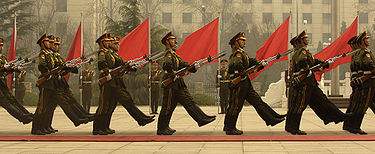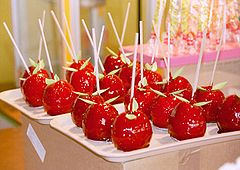- Red
-
This article is about the color. For other uses, see Red (disambiguation).
Red — Spectral coordinates — Wavelength ~620–740[1][2] nm Frequency ~480–400 THz — Common connotations — aggression, love, negativity, passion, socialism, communism, Valentine's Day, heat, fire, beauty, leadership, masculinity, injury, danger, blood, Christmas, volcanoes, conservatism (US), error, courage, stop, failure, drug intolerance, wrong way, death 
— Color coordinates —
Hex triplet #FF0000 sRGBB (r, g, b) (255, 0, 0) Source sRGB approximation to NCS S 1080-R[3] B: Normalized to [0–255] (byte) Red is any of a number of similar colors evoked by light consisting predominantly of the longest wavelengths of light discernible by the human eye, in the wavelength range of roughly 630–740 nm.[2] Longer wavelengths than this are called infrared (below red), and cannot be seen by the naked eye. Red is used as one of the additive primary colors of light, complementary to cyan, in RGB color systems. Red is also one of the subtractive primary colors of RYB color space but not CMYK color space. Sometimes certain shades of red are even used to symbolize anger, or aggression.
Contents
Etymology and definitions
The word red comes from the Old English rēad.[4] Further back, the word can be traced to the Proto-Germanic rauthaz and the Proto-Indo European root reudh-. In Sanskrit, the word rudhira means red or blood. In the English language, the word red is associated with the color of blood, certain flowers (e.g. roses), and ripe fruits (e.g. apples, cherries). Fire is also strongly connected, as is the sun and the sky at sunset. Healthy light-skinned people are sometimes said to have a "ruddy" complexion (as opposed to appearing pale). After the rise of socialism in the mid-19th century, red was used to describe revolutionary movements.[5]
In science
 Artificial red poppies
Artificial red poppies
Colorimetry, color science, photography
Red is any of a number of similar colors evoked by light consisting predominantly of the longest wavelengths of light discernible by the human eye, in the wavelength range of approximately 630–700 nm.[2] Longer wavelengths than this are called infrared, or below red and cannot be seen by human eyes.[6] Red's wavelength has been an important factor in laser technologies as red lasers, used in early compact disc technologies, are being replaced by blue lasers, as red's longer wavelength causes the laser's recordings to take up more space on the disc than blue lasers.[7] A main theory for why primates developed sensitivity to red, is that it allowed ripe fruit to be distinguished from unripe fruit and inedible vegetation.[8] This further drove other adaptations to take advantage of this new ability, such as red faces.[9] Red light is also used to preserve night vision in low-light or night-time situations, as the rod cells in the human eye are not sensitive to red.[10][11] Red is one of the three additive primary colors of light, complementary to cyan, in RGB color systems. Red is also one of the three subtractive primary colors of RYB color space but not CMYK color space.[12]
One common use of red as an additive primary color is in the RGB color model. Because red is not by itself standardized, color mixtures based on red are not exact specifications of color either. The United States government sets certain specifications for what paints to use when red is stated in a design.[13] In order for computers to produce exact colors, the color red needs to be defined in terms of an absolute color space, such as sRGB.[14] color correction (so that a standardized red is produced that is not in fact full intensity of only the red colorant).
Red illumination was (and sometimes still is) used as a safelight while working in a darkroom, as it does not expose most photographic paper and some films.[15] Though many more modern darkrooms use an amber safelight, red illumination is closely associated with the darkroom in the public mind.
Lasers
Lasers emitting in the red region of the spectrum have been available since the invention of the Ruby laser in 1960. In 1962 the red Helium-neon laser was invented[16], and these two types of lasers were widely used in many scientific applications including Holography and education. Red Helium-Neon lasers were used commercially in LaserDisc players. The use of red laser diodes became widespread with the commercial success of modern DVD players, which use a 660nm laser diode technology. Today, red and red-orange laser diodes are widely available to the public in the form of extremely inexpensive laser pointers. Portable, high powered versions of these are also available for various applications.[17] More recently, 671nm DPSS lasers have been introduced to the market for all-DPSS laser display systems, Particle image velocimetry, Raman spectroscopy, and holography.[18]
In nature
 Mars possesses a distinct red color, particularly when seen up close
Mars possesses a distinct red color, particularly when seen up close
Mars is called the Red Planet because of the reddish color imparted to its surface by the abundant iron oxide present there.[19] Astronomical objects which are moving away from the observer exhibit a red shift. Jupiter's surface displays a Great Red Spot, an oval-shaped gigantic storm south of the planet's equator.[20] Many elements exhibit a red color when burned; calcium, for example, produces a brick-red when combusted.[21]
 Red blood cell agar
Red blood cell agar
Oxygenated blood is red due to the presence of oxygenated hemoglobin.[22] When used about animal coloration red usually refers to a brownish, reddish-brown or ginger color. In this sense it is used to describe coat colors of reddish-brown cattle and dogs, and in the names of various animal species or breeds such as red fox, red squirrel, red deer, Robin Redbreast, Red Grouse, Red Knot, Redstart, Redwing, Red Setter, Red Devon cattle etc. The usage for animal color appears similar to that for red ochre, red hair and Red Indian. When used for flowers, red often refers to purplish (red deadnettle, red clover, red helleborine) or pink (red campion, red valerian) colors.
Red is associated dominance in a number of animal species.[23] For example, in mandrills red coloration of the face is greatest in alpha males, increasingly less prominent in lower ranking subordinates, and directly correlated with levels of testosterone.[24] Red can also affect the perception of dominance by others, leading to significant differences in mortality, reproductive success and parental investment between individuals displaying red and those not.[25] In humans, wearing red has been linked with increased performance in competitions, including professional sport[26][27] and multiplayer video games.[28] Controlled tests have demonstrated that wearing red does not increase performance or levels of testosterone during exercise, so the effect is likely to be produced by perceived rather than actual performance.[29] Judges of tae kwon do have been shown to favor competitors wearing red protective gear over blue,[30] and, when asked, a significant majority of people say that red abstract shapes are more "dominant", "aggressive" and "likely to win a physical competition" than blue.[23] In contrast to its positive effect in physical competition and dominance behavior, exposure to red decreases performance in cognitive tasks[31] and elicits aversion in psychological tests where subjects are placed in an "achievement" context (e.g. taking an IQ test).[32]
Symbolism
Sin, guilt, pain, passion, blood, and anger
Red is used as a symbol of guilt, sin, passion and anger, often as connected with blood or sex.[33] A Biblical example is found in Isaiah: "Though your sins be as scarlet, they shall be white as snow."[34] Also, The Scarlet Letter, an 1850 American novel by Nathaniel Hawthorne, features a woman in a Puritan New England community who is punished for adultery with ostracism, her sin represented by a red letter 'A' sewn into her clothes.[35] This all comes from a general Hebrew view inherited by Christianity which associates red with the blood of murder,[36] as well as with guilt in general. Often, things will be in red to scare.[37] Another popular example of this is in the phrase "caught red-handed", meaning either caught in an act of crime or caught with the blood of murder still on one's hands.[38] At one point, red was associated with prostitutes, or now, with brothels (red-light districts).[39][40] In Roman Catholicism, red represents wrath, one of the Seven Deadly Sins. In Christianity, Satan is usually depicted as colored red and/or wearing a red costume in both iconography and popular culture.[41] Statistics have shown that red cars are more likely to be involved in accidents.[42]
The color red is associated with lust, passion, love, beauty, and danger as well. The association with love and beauty is possibly related to the use of red roses as a love symbol.[43] Both the Greeks and the Hebrews considered red a symbol of love, as well as sacrifice.[44] Psychological research has shown that men find women who are wearing red more attractive.[45]
Courage and sacrifice
Red is used as a symbol of courage and sacrifice, as in blood spilt in sacrifice or courage in the face of lethal danger.[46] Examples of this are found in the flags of many nations including the United States, as well as in the novel The Red Badge of Courage, in which a soldier in the American Civil War discovers the meaning of courage.[47] In Christianity, red is the liturgical color for the feast of martyrs, representing the blood of those who suffered death for their faith. It is sometimes used as the liturgical color for Holy Week including Palm Sunday and Good Friday, although this is a modern (20th century) development. It is also the liturgical color used to commemmorate the Holy Spirit (for this reason it is worn at Pentecost and during Confirmation Masses). Because of its association with martyrdom and the Spirit, it is also the color used to commemmorate the Apostles (except for the Apostle St. John, who was not martyred, where white is used), and as such, it is used to commemorate Bishops, who are the successors of the Apostles (for this reason, when Funeral Masses are held for Bishops, Cardinals, or Popes, instead of the white that would ordinarily be used, red is used). In Roman mythology red is associated with the god of war, Mars.[46] A Roman general receiving a triumph had his entire body painted red in honor of his achievement.[48] Red was also the traditional color of the uniforms worn by the British Army, and such British soldiers were often known as Redcoats. The phrase "red-blooded" describes someone who is audacious, robust, or virile.[38] In Edward de Bono's book Six Thinking Hats a red hat represents feelings and emotions.[49]
Warning
 Stop sign used in various countries. The shape and color red is used nearly universally today.[citation needed]
Stop sign used in various countries. The shape and color red is used nearly universally today.[citation needed]
 Red sky at night, sailor's/shepherd's delight.
Red sky at night, sailor's/shepherd's delight.
Red catches people's attention, and can be used either in a negative way to indicate danger and emergency, or in a positive way in advertising to gain more viewers, or in nature, as a ripe fruit announces its readiness with its red color.[50] Several studies have indicated that red carries the strongest reaction of all the colors, with the level of reaction decreasing gradually with orange, yellow, and white, respectively.[51] Because of this, red is often used to catch people's attention in a variety of situations (see: penalty card).[52]
The port, or left, side of a sea-going vessel carries a red navigation light, to warn other vessels approaching from that side to change course to avoid a collision.[53] Red light is scattered the least and therefore reaches the greatest distance among all colors of the visible spectrum. Therefore, it is used as the "stop" sign at traffic signals.
Red in different cultures and traditions
In China, red (simplified Chinese: 红; traditional Chinese: 紅; pinyin: hóng) is the symbol of fire and the south (both south in general and Southern China specifically). It carries a largely positive connotation, being associated with courage, loyalty, honor, success, fortune, fertility, happiness, passion, and summer.[54][55] In Chinese cultural traditions, red is associated with weddings (where brides traditionally wear red dresses) and red paper is also frequently used to wrap gifts of money or other things. Special red packets (simplified Chinese: 红包; traditional Chinese: 紅包; pinyin: hóng bāo in Mandarin or lai see in Cantonese) are specifically used during the Chinese New Year to give monetary gifts. On the more negative side, obituaries are traditionally written in red ink, and to write someone's name in red signals either cutting them out of your life, or that they have died.[55] Red is also associated with both the feminine and the masculine (yin and yang respectively), depending on the source.[55][56]
In Japan, red is a traditional color for a heroic figure.[57] In the Indian Sub-continent, red is the traditional color of bridal dresses, and is frequently represented in the media as a symbolic color for married women. The color is associated with purity, sexuality in marriage relationships through its connection to heat and fertility.[58] It is also the color of wealth, beauty, and the goddess Lakshmi.[46]
In Central Africa, Ndembu warriors rub themselves with red during celebrations. Since their culture sees the color as a symbol of life and health, sick people are also painted with it. Like most Central African cultures, the Ndembu see red as ambivalent, better than black, but not as good as white.[59] In other parts of Africa, however, red is a color of mourning, representing death.[60] Because of the connection red bears with death in many parts of Africa, the Red Cross has changed its colors to green and white in parts of the continent.[61]
The early Ottoman Turks led by the first Ottoman Sultan Osman I, carried red banners symbolizing Sovereignty, Ghazis and Sufism, until according to legend he saw a new Red flag in his dream inlaid with a Crescent.
In sports
Teams throughout the world wear red on their uniforms. Major League Baseball is especially well known for red teams. Numerous teams in various sports use red in their team colors.[62]
The Cincinnati Red Stockings are the oldest professional baseball team, dating back to 1869.[63] The franchise soon relocated to Boston and is now the Atlanta Braves, but its name survives as the origin for both the Cincinnati Reds and Boston Red Sox. During the 1950s when red was so strongly associated with communism, the modern Cincinnati team was known as the "Redlegs" and the term was even used on baseball cards. After the red scare faded, the team was known as the Reds again.[64] The Los Angeles Angels of Anaheim are also known for their color red, as well as the St. Louis Cardinals and the Philadelphia Phillies.
In the NHL, red jerseys are worn by the Detroit Red Wings, Washington Capitals, Calgary Flames, Carolina Hurricanes, Chicago Blackhawks, Colorado Avalanche, Minnesota Wild, Montreal Canadiens, New York Rangers, Ottawa Senators, Phoenix Coyotes, and the New Jersey Devils.
In association football, teams that wear red as part of their kit include Manchester United, Liverpool, Arsenal, AFC Ajax, Toronto FC, Bayern Munich, AC Milan, Olympiacos and S.L. Benfica. In rugby union, Ireland's Munster rugby, New Zealand's Canterbury provincial team and Crusaders Super 14 rugby side wear red as a major color in their playing strips.
In the NFL, teams with a shade of the color red as the primary color of either the team's dark "home" jersey (or an alternate thereof) or its "throwback" jersey consist of the: Arizona Cardinals, Atlanta Falcons, Houston Texans, Kansas City Chiefs, New England Patriots, New York Giants, San Francisco 49ers, Tampa Bay Buccaneers and Washington Redskins.
The Cleveland Cavaliers basketball team use a deeper shade of red called wine. Fellow National Basketball Association team the Los Angeles Clippers wear red uniforms on their road games, as do the Chicago Bulls, Atlanta Hawks, Portland Trail Blazers, and as done by the Houston Comets of the WNBA. A similar shade to the Cavaliers' tone, (known in this instance as claret) is used by English association football teams Aston Villa, West Ham United, and Burnley.
Numerous national teams wear red, often through association with their national flags. These national sides include representative teams in various sports from Spain (in soccer, nicknamed "The Red Fury"), England, Wales, Canada, Denmark, Tonga, Chile, Puerto Rico, Russia and Switzerland.
In boxing, red is often the color used on fighter's gloves. George Foreman wore the same red trunks he used for his loss to Muhammad Ali when he defeated Michael Moorer 20 years later to recuperate the title he lost to Ali. Boxers named or nicknamed "red" include Red Burman, Ernie "Red" Lopez and his brother Danny "Little Red" Lopez.
On flags
Red is one of the most common colors used on national flags. The use of red has similar connotations from country to country: the blood, sacrifice, and courage of those who defended their country; the sun and the hope and warmth it brings; and the sacrifice of Christ's blood (in some historically Christian nations) are a few examples. Red is the color of the flags of several countries which once belonged to the former British Empire. The British flag bears the colors red, white and blue; it includes the cross of Saint George, patron saint of England, and the saltire of Saint Patrick, patron saint of Ireland, both of which are red on white.[65] The United States flag bears the colors of Britain,[66] the colors of the French tricolore include red as part of the old Paris coat of arms, and other countries' flags, such as those of Australia, New Zealand and Fiji, carry a small inset of the British flag in memory of their ties to that country.[67] Former colonies of Spain, such as Mexico, Colombia, Ecuador, Cuba, Puerto Rico, Peru and Venezuela, also feature red, one of the colors of the Spanish flag, on their own banners. Red flags are also used to symbolize storms, bad water conditions, and many other things. Navy flags are often Red and Yellow. Red is prominently featured in the flag of the United States Marine Corps.
Red symbolizes the flag of Nepal. This color represents the floral emblem of Nepal, the rhododendron.
Red, blue and white are also the Pan-Slavic colors adopted by the Slavic solidarity movement of the late nineteenth century. Initially these were the colors of the Russian flag; as the Slavic movement grew, they were adopted by other Slavic peoples including Slovaks, Slovenes and Serbs. The flags of the Czech Republic and Poland, which contain red use it for historic heraldic reasons (see Coat of arms of Poland and Coat of arms of the Czech Republic), not due to Pan-Slavic connotations.
Red, white, and black are the colors of Pan-Arabism, and are used by many Arab countries.[68]
Red, gold, green and black are the colors of Pan-Africanism. Several African countries thus use the color on their flags, including South Africa, Ghana, Senegal, Mali, Ethiopia, Togo, Guinea, Benin, and Zimbabwe. The Pan-African colors are borrowed from the flag of Ethiopia, one of the oldest independent African countries.[68][69] Rwanda, notably, removed red from its flag after the Rwandan Genocide, because Pan-Africanism was so strongly associated with the event and because of red's association with blood.[70]
For other reasons, the flag of Japan has a red circle in the middle. The flag of the Philippines has a red trapezoid on the bottom signifying blood, courage, and valor [also, if the flag is inverted so that the red trapezoid is on top and the blue at the bottom, it indicates a state of war]. The flag of Singapore has a red rectangle on the top. The field of the flag of Portugal is green and red.
Use by political movements
As early as the 9th century, the Khurramites successors to the Mazdak religion and proto-communists in the Middle Ages of the Middle East used red as their symbol for revolution. Even before Europe's Revolutions of 1848, Socialist red was used as a color of European Revolutionaries, often in the form of the red flag. It was also used by Garibaldi's camicie rosse (redshirts) in the Italian Risorgimento, and taken up by Leftist and generally revolutionary groups, while the white of legitimist Bourbon partisans became associated with pre-World War I conservatives. This relates to the term "Blood of the workers", representing the suffering of the proletariat. For instance the Civil War in Russia and the Civil War in Finland were fought between the Red Army and various White Armies.
Members of the Communist Chinese military honor guard.
The identification of Communism with Socialist red (with the red flag being the primary color of the flag of the Soviet Union) and the red star being a Communist emblem led to such Cold War phrases as "the Red Menace" and "Red China" (distinguished from Nationalist China, "Blue China" or "Free China"). China's de-facto anthem under Mao Zedong was "The East Is Red".[71] Mao Zedong was sometimes referred to as a "red sun".[72] The color was also associated with political vehicles such as the Red Guard in China and the Red Guards during the Russian Revolution of 1917 as well as with left wing paramilitary terrorist groups such as the Red Army Faction in Germany and the Japanese Red Army. Red remains associated with parties on the left of the political spectrum.
Social-democratic political parties throughout the world, particularly in Europe, are most commonly symbolized by the color red. Red is the color associated with the Popular Democratic Party of Puerto Rico.
In the United States, red is associated with the center-right Republican Party and blue with the Democrats – a reverse of the traditional European scheme. This convention is relatively recent: before the 2000 presidential election, media outlets assigned red and blue (the colors of the American flag) to both parties, sometimes alternating each election. The fixed usage became established in during the 39-day recount following the 2000 election, when coverage began discussing the contest in terms of "red states" versus "blue states".[73]
Food and drink
Most red foods derive from one of two sources. Plants like apples, strawberries, cherries, tomatoes, peppers and pomegranates are often colored by forms of carotenoids, red pigments that were originally developed to assist photosynthesis.[74] Meat gets its color from the iron found in the myoglobin and hemoglobin in the muscles and residual blood.[75]
Society
The Red Hat Society is a social group founded in 1998 for women 50 and over.
Business
Red is associated with a number of worldwide companies and brands, which use the color prominently on their logos and advertisement. Some include:
- Air France
- Air India
- Air Canada
- Air China
- American Airlines
- APC by Schneider Electric
- Avianca
- Avis Rent a Car System
- Baker's Supermarkets
- Buca di Beppo
- Budweiser
- Burger King
- Castle Cement
- Circle K
- Coca Cola
- Coors
- CVS Pharmacy
- Delta Air Lines
- DHL
- Dillons
- Dixie-Narco
- Exxon
- Fred Meyer
- Fry's Electronics
- Fry's Food and Drug
- Genie Company
- Iberia
- Japan Airlines
- JayC Food Stores
- King Soopers & City Market
- K-Mart
- K-Mart Australia
- Kodak
- LG Corp
- Marlboro
- Marriott International
- Marsh Supermarkets
- Mattel
- McDonald's
- Motorola Mobility
- Owen's Market
- Pay Less Food Markets
- Pepsi Cola
- Pizza Hut
- Pueblo Supermarkets
- Redbox
- Red Devil
- Red Roof Inn
- Revlon
- Safeway Supermarkets
- Sally Beauty Supply
- Schindler Group
- Scott's Food & Pharmacy
- Shell
- Smith's Food and Drug
- TAM
- TAM Paraguay
- Target
- Televicentro
- Tesco
- Texaco
- Verizon
- Virgin Group
- Walgreens
- Winston
In film
Many movie titles have included the color's name in them, such as:
- Red, a Tamil movie from 2002
- Red, an American movie from 2008
- Red, an action comedy from 2010, starring Bruce Willis
- Red Riding Hood
- Red Dog (film), 2011 Australian film
- Reds
- The Woman in Red, a 1935 American film
- The Woman in Red, a 1984 American comedy film
See also
References
- ^ Thomas J. Bruno, Paris D. N. Svoronos. CRC Handbook of Fundamental Spectroscopic Correlation Charts. CRC Press, 2005.
Color - ^ a b c Craig F. Bohren (2006). Fundamentals of Atmospheric Radiation: An Introduction with 400 Problems. Wiley-VCH. p. 214. ISBN 3527405038. http://books.google.com/books?visbn=3527405038&id=1oDOWr_yueIC&pg=PA214&lpg=PA214&ots=Jrfi5sPBhk&dq=indigo+spectra+blue+violet+date:1990-2007&sig=Rm2xP5mIgyGJ1a1pbfAt65QSf0I#PPA214,M1.
- ^ The sRGB values are taken by converting the NCS color 1080-R using the “NCS Navigator” tool at the NCS website.
- ^ Eric Partridge (1966). Origins: An Etymological Dictionary of Modern English. Routledge. ISBN 0415050774. http://books.google.com/books?id=xA9dxrhfa5kC&pg=PA555&dq=red+read+rauthaz&lr=&as_brr=0&ei=YvmfR_3qCoqqswOjkp2yCg&sig=S8ASNhN9nYv1Q6EcrdN2ja3W5kA.
- ^ Douma, Michael (2008). "Color of Power". Pigments Through the Ages. Institute for Dynamic Educational Development. http://www.webexhibits.org/pigments/intro/reds4.html. Retrieved 18 April 2010.
- ^ "What Wavelength Goes With a Color?". Atmospheric Science Data Center. http://eosweb.larc.nasa.gov/EDDOCS/Wavelengths_for_Colors.html. Retrieved 2009-04-15.
- ^ DVD
- ^ O'Neil, Dennis (March 19, 2010). "Primate Color Vision". Primates. San Marcos, CA: Palomar Community College. http://anthro.palomar.edu/primate/color.htm. Retrieved 22 April 2010.
- ^ Hogan, Dan; Michele Hogan (May 25, 2007). "Color Vision Drove Primates To Develop Red Skin And Hair, Study Finds". Science News. Rockville, MD: ScienceDaily. http://www.sciencedaily.com/releases/2007/05/070524155313.htm. Retrieved 22 April 2010.
- ^ "Human Vision and Color Perception". Olympus Microscopy Resource Center. http://www.olympusmicro.com/primer/lightandcolor/humanvisionintro.html. Retrieved 2007-09-19.
- ^ "Be a Stargazer". Sensitize Your Eyes. http://www.pbs.org/wgbh/nova/worlds/stargazer.html#Sensitize%20Your%20Eyes. Retrieved 2007-09-25.
- ^ Primary Colors: Additive and Subtractive - An Educator's Reference Desk Lesson Plan
- ^ U.S. Army (December 15, 1989). "Federal Standard 595b Colors Used In Government Procurement". 595 Paint Spec. Stanton, CA: FastPoint Technologies. pp. 3. http://www.fed-std-595.com/images/fed-std-595.pdf. Retrieved 22 April 2010.
- ^ Süsstrunk, Sabine; Robert Buckley, Steve Swen. "Standard RGB Color Spaces". Laboratory of audio-visual Communication. pp. 1. http://infoscience.epfl.ch/record/34089/files/SusstrunkBS99.pdf?version=1. Retrieved 18 April 2010.
- ^ "Important Facts About Safelights". How Safe is Your Safelight?. Eastman Kodak. http://www.kodak.com/global/en/consumer/products/techInfo/k4/k4Facts.shtml. Retrieved 18 April 2010.
- ^ A.D. White and J.D. Rigden, "Continuous Gas Maser Operation in the Visible". Proc IRE vol. 50, p1697: July 1962. US Patent 3242439.
- ^ "Laserglow - Blue, Red, Yellow, Green Lasers". Laserglow.com. http://www.laserglow.com/GRH. Retrieved 2011-09-20.
- ^ "Laserglow – Lab/OEM Lasers". Laserglow.com. http://www.laserglow.com/GRH. Retrieved 2011-09-20.
- ^ Adams, Melanie; Natasha Raynor (9/19/94-03/12/09). "Mars, The Red Planet". MidLink Magazine. North Carolina State University. http://www.cs.ucf.edu/~MidLink/Mars.html. Retrieved 12 April 2010.
- ^ Cardall, Christian; Steven Daunt (2003). "The Great Red Spot". The Solar System. University of Tennessee. http://csep10.phys.utk.edu/astr161/lect/jupiter/redspot.html. Retrieved 12 April 2010.
- ^ C. Michael Hogan. 2010. Calcium. eds. A.Jorgensen, C.Cleveland. Encyclopedia of Earth. National Council for Science and the Environment.
- ^ Nabili, Siamak. "Hemoglobin". Procedures and Tests. MedicineNet. pp. 1. http://www.medicinenet.com/hemoglobin/article.htm. Retrieved 12 April 2010.
- ^ a b Little, A. C.; Hill, R. A. (2007). "Attribution to red suggests special role in dominance signalling". Journal of Evolutionary Psychology 5: 161. doi:10.1556/JEP.2007.1008.
- ^ Setchell, J.; Smith, T.; Wickings, E.; Knapp, L. (2008). "Social correlates of testosterone and ornamentation in male mandrills". Hormones and Behavior 54 (3): 365–372. doi:10.1016/j.yhbeh.2008.05.004. PMID 18582885.
- ^ Cuthill, I. C.; Hunt, S.; Cleary, C.; Clark, C. (1997). "Colour bands, dominance, and body mass regulation in male zebra finches (Taeniopygia guttata)". Proceedings of the Royal Society B: Biological Sciences 264 (1384): 1093. doi:10.1098/rspb.1997.0151.
- ^ Hill, R. A.; Barton, R. A. (2005). "Psychology: Red enhances human performance in contests". Nature 435 (7040): 293. Bibcode 2005Natur.435..293H. doi:10.1038/435293a.
- ^ Attrill, M.; Gresty, K.; Hill, R.; Barton, R. (2008). "Red shirt colour is associated with long-term team success in English football". Journal of Sports Sciences 26 (6): 577–582. doi:10.1080/02640410701736244. PMID 18344128.
- ^ Ilie, A.; Ioan, S.; Zagrean, L.; Moldovan, M. (2008). "Better to Be Red than Blue in Virtual Competition". CyberPsychology & Behavior 11 (3): 375. doi:10.1089/cpb.2007.0122.
- ^ Hackney, A. C. (2005). "Testosterone and human performance: influence of the color red". European Journal of Applied Physiology 96 (3): 330–333. doi:10.1007/s00421-005-0059-7. PMID 16283371.
- ^ Hagemann, N.; Strauss, B.; Leißing, J. (2008). "When the Referee Sees Red …". Psychological Science 19 (8): 769–771. doi:10.1111/j.1467-9280.2008.02155.x. PMID 18816283.
- ^ Elliot, A. J.; Maier, M. A. (2007). "Color and Psychological Functioning". Current Directions in Psychological Science 16: 250. doi:10.1111/j.1467-8721.2007.00514.x.
- ^ Elliot, A. J.; Maier, M. A.; Binser, M. J.; Friedman, R.; Pekrun, R. (2008). "The Effect of Red on Avoidance Behavior in Achievement Contexts". Personality and Social Psychology Bulletin 35 (3): 365–375. doi:10.1177/0146167208328330. PMID 19223458.
- ^ Oehler, Gustav Friedrich and George Edward Day, Theology of the Old Testament. pg. 320
- ^ KJV Isaiah 1:18
- ^ Hawthorne, Nathaniel. The Scarlet Letter. New York: Pocket, 2004. ISBN 0-7434-8756-7 pg. 136
- ^ Hecht, Mendy. "Seven Things You Can Do for America". http://www.noahide.org/article.asp?Level=179&Parent=342. Retrieved 2009-10-05.
- ^ Atwater, Edward. Sacred Tabernacle of the Hebrews. City: Kessinger Publishing, LLC, 2004. ISBN 1-4179-7818-X pg. 223
- ^ a b Oxford English Dictionary
- ^ Haarmann, Harald. Language in Its Cultural Embedding. Berlin: Mouton de Gruyter, 1990. ISBN 0-89925-583-3 pg. 13
- ^ Delaney, Carol. Investigating Culture. Cambridge: Blackwell Pub, 2004. ISBN 0-631-22237-5 pg. 324
- ^ Steffler, Alva. Symbols of the Christian Faith. City: Wm. B. Eerdmans Publishing Company, 2002. ISBN 0-8028-4676-9 pg. 132
- ^ Kopacz, Jeanne. Color in Three-Dimensional Design. New York: McGraw-Hill, 2004. ISBN 0-07-141170-4 pg. 76
- ^ Sebeok, Thomas and Marcel Danesi. The Forms of Meaning: Modeling Systems Theory and Semiotic Analysis. Berlin: Mouton de Gruyter, 1999. ISBN 3-11-016751-4 pgs. 150-152
- ^ Dreyfuss, Henry. Symbol Sourcebook. New York: Wiley, 1984. ISBN 0-471-28872-1 pg. 239
- ^ Red on Women Drives Men Wild also http://www.foxnews.com/story/0,2933,444415,00.html
- ^ a b c Feisner, Edith. Colour. City: King Laurence Publish, 2006. ISBN 1-85669-441-0 pg. 127
- ^ Hoffman, Daniel. The Poetry of Stephen Crane. New York: Columbia University Press, 1971. ISBN 0-231-08662-8 pg. 150
- ^ Ramsay, William (1875). "Triumphus". http://penelope.uchicago.edu/Thayer/E/Roman/Texts/secondary/SMIGRA*/Triumphus.html. Retrieved 2007-12-09.
- ^ Published by Little, Brown and Company in 1985 ISBN 0-316-17791-1 (hardback) and 0316178314 (paperback).
- ^ Judd, Charles Hubbard. Psychology: General Introduction. Pgs. 131-132
- ^ Robertson, S. (Editor). Contemporary Ergonomics 1996. Boca Raton: CRC, 1996. ISBN 0-7484-0549-6 pgs. 148-150
- ^ Karwowski, Waldemar. International Encyclopedia of Ergonomics and Human Factors, Second Edition - 3 Volume Set. Boca Raton: CRC, 2006. ISBN 0-415-30430-X pg. 1518
- ^ Llana, Chris; George Wisneskey (October 23, 2006). "22". Handbook of the Nautical Rules of the Road. A (2/3 ed.). Annapolis, Md.: Naval Institute Press. pp. 103. ISBN 978-1557505040. http://navruleshandbook.com/Rule22.html. Retrieved April 18, 2010.
- ^ Li Sujun (李素军), China Red (中国红). (In Chinese.)
- ^ a b c Cullen, Cheryl. Global Graphics. Gloucester: Rockport Publishers, 2000. ISBN 1-56496-293-8 pg. 147
- ^ Hodge, Bob and Kam Louie. The Politics of Chinese Language and Culture. New York: Routledge, 1998. ISBN 0-415-17266-7 pg. 132
- ^ "PS2 News: CVG goes straight to hell with Devil May Cry director - ComputerAndVideoGames.com:". http://www.computerandvideogames.com/article.php?id=17957. Retrieved 2007-10-14.
- ^ Lamb, Sarah. White Saris and Sweet Mangoes. Berkeley: University of California Press, 2000. ISBN 0-520-22001-3 pg. 188
- ^ Banton, Michael. Anthropological Approaches to the Study of Religion. New York: Routledge, 2004. ISBN 0-415-33021-1 pg. 57
- ^ Bradley, Carolyn. Western World Costume. New York: Dover Publications, 2001. ISBN 0-486-41986-X pg. 8
- ^ Austin, Erica and Bruce Pinkleton. Strategic Public Relations Management: Planning and Managing Effective Communication Programs. Hillsdale: Lawrence Erlbaum Associates, 2006. ISBN 0-8058-5381-2 pg. 301
- ^ Dart, Tom (March 12, 2008). "Teams with red shirts have a head start". Times Online (London: News International Group). http://www.timesonline.co.uk/tol/sport/football/article3533300.ece. Retrieved 13 April 2010.
- ^ Frommer, Harvey (April 9, 2010). "First Professional Baseball Team: Flashback". Dr. Harvey Frommer on Sports. Diamond Bar, California: Travel Watch. http://www.travel-watch.com/firstprobaseballteam.htm. Retrieved 18 April 2010.
- ^ Cuordileone, K.A. Manhood and American Political Culture in the Cold War. New York: Routledge, 2005. ISBN 0-415-92599-1 pg. XIII
- ^ Brabazon, Tara. Tracking the Jack. Sydney: UNSW Press, 2000. ISBN 0-86840-699-6 pg. 10
- ^ "The United States Flag - Public and Intergovernmental Affairs". United States Department of Veterans Affairs. http://www1.va.gov/opa/feature/celebrate/Flag.asp. Retrieved December 7, 2006.
- ^ Brabazon, Tara. Tracking the Jack. Sydney: UNSW Press, 2000. ISBN 0-86840-699-6 pgs. 13-20
- ^ a b Colors as Symbols in Flags: EnchantedLearning.com
- ^ Murrell, Nathaniel et al. Chanting down Babylon. Philadelphia: Temple University Press, 1998. ISBN 1-56639-584-4 pg. 135
- ^ Rwandan: Adoption of the new flag
- ^ "The East Is Red". TIME. 1970-05-04. http://www.time.com/time/magazine/article/0,9171,943793,00.html. Retrieved 2009-04-10.
- ^ "The Reddest Red Sun". Morning Sun. http://www.morningsun.org/red/redfamily_cp_69.html. Retrieved 2009-04-10.
- ^ Farhi, Paul (2 November 2004). "Elephants Are Red, Donkeys Are Blue". The Washington Post. http://www.washingtonpost.com/wp-dyn/articles/A17079-2004Nov1.html. Retrieved 19 April 2011.
- ^ Speer, Brian. "Photosynthetic Pigments". UCMP Glossary. University of California: University of California Museum of Palentology. http://www.ucmp.berkeley.edu/glossary/gloss3/pigments.html. Retrieved 22 April 2010.
- ^ Fleming, H.P.; T. N. Blumer, H. B. Craig (1960). "Quantitative Estimations Of Myoglobin And Hemoglobin In Beef Muscle Extracts". Journal of Animal Sciences. North Carolina Agricultural Experiment Station, Raleigh: American Society of Animal Science. pp. 2. http://jas.fass.org/cgi/reprint/19/4/1164.pdf. Retrieved 22 April 2010.
External links
- Seeing Red - slideshow by Life magazine
Shades of redAmaranth Auburn Burgundy Cardinal Carmine Cerise Chestnut Crimson Dark red Electric crimson Fire brick Flame Folly Fuchsia Lust Magenta Raspberry Red Red-violet Redwood Rose Rosewood Rust Scarlet Terra cotta Tuscan red Vermilion Wine The samples shown above are only indicative. Electromagnetic spectrum ← higher frequencies longer wavelengths →
Gamma rays · X-rays · Ultraviolet · Visible · Infrared · Terahertz radiation · Microwave · RadioVisible (optical) Microwaves Radio Wavelength types Web colorsblack gray silver white maroon red purple fuchsia green lime olive yellow navy blue teal aqua Color topics Color perception Color space Basic colors Related Categories:- Shades of red
- Optical spectrum
- Color
Wikimedia Foundation. 2010.





